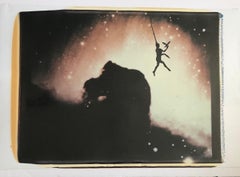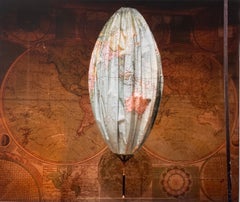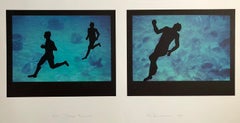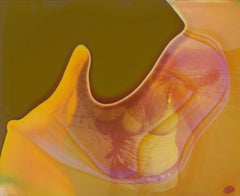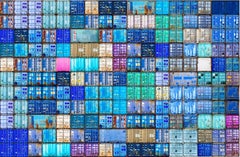Eve Sonneman Abstract Photography
to
1
1
1
Overall Width
to
Overall Height
to
3
1
2
3
3
2
1
9
464
451
127
92
3
Artist: Eve Sonneman
Vintage 20X24 Format Polaroid Signed Surrealist Photograph Eve Sonneman Photo
By Eve Sonneman
Located in Surfside, FL
This is from a show at Sidney Janis Gallery and is from the estate of Joan Sonnabend.
Eve Sonneman (born in Chicago on 1946) is an American photographer and artist. She did a series ...
Category
1990s Contemporary Eve Sonneman Abstract Photography
Materials
Color, Polaroid
Vintage Signed Surrealist Color Photograph Eve Sonneman Cibachrome Art Photo AP
By Eve Sonneman
Located in Surfside, FL
The Deflated World, 1981
Cibachrome, this is the rare AP (Artists Proof) outside the edition of 10
Hand signed by artist and dated
20 × 24 in
50.8 × 61 cm
Eve Sonneman (born in Chic...
Category
1980s Contemporary Eve Sonneman Abstract Photography
Materials
Color, Polaroid
Large Diptych "Deep runners" Photograph Signed Surrealist Photo Lithograph
By Eve Sonneman
Located in Surfside, FL
Deep Runners, Hand signed, dated,and numbered from limited edition.
This is from a show at Sidney Janis Gallery and is from the estate of Joan Sonnabend.
Eve Sonneman (born in Chica...
Category
1990s Contemporary Eve Sonneman Abstract Photography
Materials
Paper, Color
Related Items
Living in a Dream (Till Death do us Part) - Contemporary, Polaroid, Women
By Stefanie Schneider
Located in Morongo Valley, CA
Living in a Dream (Till Death do us Part) - 2005
20x20cm,
Edition of 10,
Archival C-Print print, based on the Polaroid.
Certificate and Signature label, artist Inventory No. 9781.
Not mounted.
on offer is a piece from the movie "Till Death do us Part"
Stefanie Schneider’s Till Death Do Us Part
or “There is Only the Desert for You.”
BY DREW HAMMOND
Stefanie Schneider’s Til Death to Us Part is a love narrative that comprises three elements:
1.
A montage of still images shot and elaborated by means of her signature technique of using Polaroid formats with outdated and degraded film stock in natural light, with the resulting im ages rephotographed (by other means) enlarged and printed in such a way as to generate further distortions of the image.
2.
Dated Super 8 film footage without a sound track and developed by the artist.
3.
Recorded off-screen narration of texts written by the actors or photographic subjects, and selected by the artist.
At the outset, this method presupposes a tension between still and moving image; between the conventions about the juxtaposition of such images in a moving image presentation; and, and a further tension between the work’s juxtaposition of sound and image, and the conventional relationship between sound and image that occurs in the majority of films. But Till Death Do Us Part also conduces to an implied synthesis of still and moving image by the manner in which the artist edits or cuts the work.
First, she imposes a rigorous criterion of selection, whether to render a section as a still or moving image. The predominance of still images is neither an arbitrary residue of her background as a still photographer—in fact she has years of background in film projects; nor is it a capricious reaction against moving picture convention that demands more moving images than stills. Instead, the number of still images has a direct thematic relation to the fabric of the love story in the following sense. Stills, by definition, have a very different relationship to time than do moving images. The unedited moving shot occurs in real time, and the edited moving shot, despite its artificial rendering of time, all too 2009often affords the viewer an even greater illusion of experiencing reality as it unfolds. It is self-evident that moving images overtly mimic the temporal dynamic of reality.
Frozen in time—at least overtly—still photographic images pose a radical tension with real time. This tension is all the more heightened by their “real” content, by the recording aspect of their constitution. But precisely because they seem to suspend time, they more naturally evoke a sense of the past and of its inherent nostalgia. In this way, they are often more readily evocative of other states of experience of the real, if we properly include in the real our own experience of the past through memory, and its inherent emotions.
This attribute of stills is the real criterion of their selection in Til Death Do Us Part where consistently, the artist associates them with desire, dream, memory, passion, and the ensemble of mental states that accompany a love relationship in its nascent, mature, and declining aspects.
A SYNTHESIS OF MOVING AND STILL IMAGES BOTH FORMAL AND CONCEPTUAL
It is noteworthy that, after a transition from a still image to a moving image, as soon as the viewer expects the movement to continue, there is a “logical” cut that we expect to result in another moving image, not only because of its mise en scène, but also because of its implicit respect of traditional rules of film editing, its planarity, its sight line, its treatment of 3D space—all these lead us to expect that the successive shot, as it is revealed, is bound to be another moving image. But contrary to our expectation, and in delayed reaction, we are startled to find that it is another still image.
One effect of this technique is to reinforce the tension between still and moving image by means of surprise. But in another sense, the technique reminds us that, in film, the moving image is also a succession of stills that only generate an illusion of movement. Although it is a fact that here the artist employs Super 8 footage, in principle, even were the moving images shot with video, the fact would remain since video images are all reducible to a series of discrete still images no matter how “seamless” the transitions between them.
Yet a third effect of the technique has to do with its temporal implication. Often art aspires to conflate or otherwise distort time. Here, instead, the juxtaposition poses a tension between two times: the “real time” of the moving image that is by definition associated with reality in its temporal aspect; and the “frozen time” of the still image associated with an altered sense of time in memory and fantasy of the object of desire—not to mention the unreal time of the sense of the monopolization of the gaze conventionally attributed to the photographic medium, but which here is associated as much with the yearning narrator as it is with the viewer.
In this way, the work establishes and juxtaposes two times for two levels of consciousness, both for the narrator of the story and, implicitly, for the viewer:
A) the immediate experience of reality, and
B) the background of reflective effects of reality, such as dream, memory, fantasy, and their inherent compounding of past and present emotions.
In addition, the piece advances in the direction of a Gesammtkunstwerk, but in a way that reconsiders this synaesthesia as a unified complex of genres—not only because it uses new media that did not exist when the idea was first enunciated in Wagner’s time, but also because it comprises elements that are not entirely of one artist’s making, but which are subsumed by the work overall. The totality remains the vision of one artist.
In this sense, Till Death Do Us Part reveals a further tension between the central intelligence of the artist and the products of other individual participants. This tension is compounded to the degree that the characters’ attributes and narrated statements are part fiction and part reality, part themselves, and part their characters. But Stefanie Schneider is the one who assembles, organizes, and selects them all.
THE RELATIONSHIP BETWEEN THIS IDEA (above) AND PHOTOGRAPHY
This selective aspect of the work is an expansion of idea of the act of photography in which the artistic photographer selects that which is already there, and then, by distortion, definition or delimitation, compositional and lighting emphasis, and by a host of other techniques, subsumes that which is already there to transform it into an image of the artist’s contrivance, one that is no less of the artist’s making than a work in any other medium, but which is distinct from many traditional media (such as painting) in that it retains an evocation of the tension between what is already there and what is of the artist’s making. Should it fail to achieve this, it remains, to that degree, mere illustration to which aesthetic technique has been applied with greater or lesser skill.
The way Til Death Do Us Part expands this basic principle of the photographic act, is to apply it to further existing elements, and, similarly, to transform them. These additional existing elements include written or improvised pieces narrated by their authors in a way that shifts between their own identities and the identities of fictional characters. Such characters derive partially from their own identities by making use of real or imagined memories, dreams, fears of the future, genuine impressions, and emotional responses to unexpected or even banal events. There is also music, with voice and instrumental accompaniment. The music slips between integration with the narrative voices and disjunction, between consistency and tension. At times it would direct the mood, and at other times it would disrupt.
Despite that much of this material is made by others, it becomes, like the reality that is the raw material of an art photo, subsumed and transformed by the overall aesthetic act of the manner of its selection, distortion, organization, duration, and emotional effect.
* * *
David Lean was fond of saying that a love story is most effective in a squalid visual environment. In Til Death Do Us Part, the squalor of the American desert...
Category
Early 2000s Contemporary Eve Sonneman Abstract Photography
Materials
Archival Paper, Photographic Paper, C Print, Color, Polaroid
$380
H 7.88 in W 9.45 in D 0.04 in
Unfinished Sky
Located in New York, NY
After a career of more than 30 years in the research of textures (20 years as a textile stylist and 10 years as interior design architect), Didier Engels has shifted towards photogra...
Category
2010s Contemporary Eve Sonneman Abstract Photography
Materials
Resin, Epoxy Resin, Paper, Archival Paper, Photographic Paper, Pigment, ...
Untitled (Paradise) - Contemporary, Nude, Men, Polaroid
By Stefanie Schneider
Located in Morongo Valley, CA
Untitled (Paradise) - 1999,
98x97cm.
Edition 3/10.
Archival C-Print, based on the original Polaroid.
Signature label and Certificate.
Artist Inventory No. 20451.
Not mounted. ...
Category
Early 2000s Contemporary Eve Sonneman Abstract Photography
Materials
Archival Paper, Photographic Paper, C Print, Color, Polaroid
$3,500
H 38.59 in W 38.19 in D 0.04 in
Boy at Twelve - Contemporary, Polaroid, Childhood
By Cristina Fontsare
Located in Morongo Valley, CA
Boy at Twelve - 2019 -
40x50cm, Edition of 10, plus 2 Artist Proofs.
Archival Print on Canson Barita Fiber Rag 340gr,
based on a reclaimed Fuji Instant Film Negative (not mounted...
Category
2010s Contemporary Eve Sonneman Abstract Photography
Materials
Archival Paper, Photographic Paper, Color, Archival Pigment, Polaroid
$946
H 15.75 in W 19.69 in D 0.04 in
The Argument (Till Death do us Part) - Contemporary, Polaroid
By Stefanie Schneider
Located in Morongo Valley, CA
The Argument (Till Death do us Part) - 2007
60x50cm,
Edition of 10 plus 2 Artist Proofs.
Archival C-Print, based on the original Polaroid.
Certificate and Signature label.
Arti...
Category
Early 2000s Contemporary Eve Sonneman Abstract Photography
Materials
Archival Paper, Photographic Paper, C Print, Color, Polaroid
$700
H 23.63 in W 19.69 in D 0.04 in
Erosion 1, 2018
By David Ondrik
Located in Sante Fe, NM
A photogram is a cameraless photographic image made by placing objects directly onto the surface of a light-sensitive material, such as photographic paper, and then exposing the mate...
Category
2010s Contemporary Eve Sonneman Abstract Photography
Materials
Photographic Paper, Photogram
Primordial
By David Ondrik
Located in Sante Fe, NM
A photogram is a cameraless photographic image made by placing objects directly onto the surface of a light-sensitive material, such as photographic paper, and then exposing the mate...
Category
2010s Contemporary Eve Sonneman Abstract Photography
Materials
Photographic Paper, Photogram
Marrying an Apple Tree (Negative) - Contemporary, Polaroid, Photograph
By Cristina Fontsare
Located in Morongo Valley, CA
Marrying an Apple Tree (Negative) - 2020
60x50cm,
Edition of 10.
Giclée Print on Hahnemühle Fine Art Baryta (glossy), based on a Peel Apart Polaroid Film (not mounted).
Signed on...
Category
2010s Contemporary Eve Sonneman Abstract Photography
Materials
Archival Ink, Archival Paper, Color, Archival Pigment, Polaroid
$1,300
H 23.63 in W 19.69 in D 0.04 in
Explosion - Colour photography, Contemporary Limited edition print, Chaos
By Sam Thomas
Located in Sant Cugat del Vallès, Barcelona
Explosion - Limited edition pigment print , 2014 - Limited Editions of 20
Signed + numbered by artist with certificate of authenticity.
Archival pigment print available sizes ( Image size , the white margin is not counted) :
42.33 x 63,5 cm / 16.66" x 25" - Edition of 20
67.73 x 101.6 cm / 26.66" x 40" - Edition of 15
This print that is being offered is a high-quality Archival Pigment print, which has been printed
on fiber-based paper. The paper used is Hahnemühle Photo Rag® Baryta 315 gsm, which is
a premium quality paper that is acid-free and lignin-free. This ensures that the print will remain
in pristine condition for years to come.
The Hahnemühle Photo Rag® Baryta paper is a museum-quality paper that is highly resistant
to aging. It is a popular alternative to analogue baryta paper, which is known for its ability to
produce rich, deep blacks and vibrant colors. The Hahnemühle Photo Rag® Baryta paper is no
different, as it produces stunningly vivid and lifelike prints.
Overall, this Archival Pigment print is a stunning piece of art that is sure to impress. The
combination of high-quality paper and inks ensures that the print will remain in pristine condition
for many years, making it a great investment for any art collector or enthusiast.
Sam Thomas...
Category
2010s Contemporary Eve Sonneman Abstract Photography
Materials
Archival Paper, Photographic Paper, Color, Pigment, Archival Pigment, Di...
$1,774
H 26.66 in W 40 in D 0.02 in
Stillness (Zuma Beach)
By Stefanie Schneider
Located in Morongo Valley, CA
Stillness (Zuma Beach) - 2004
29x28cm,
Edition of 10, plus 2 Artist Proofs.
Archival C-Print, based on the Polaroid.
Certificate and Signature label.
Artist Inventory #20433.
N...
Category
Early 2000s Contemporary Eve Sonneman Abstract Photography
Materials
Metal
Untitled (Paradise) - Contemporary, Nude, Men, Polaroid
By Stefanie Schneider
Located in Morongo Valley, CA
Untitled (Paradise) - 1999,
20x20cm. Edition of 10, plus 2 Artist Proofs.
Archival C-Print, based on a Polaroid.
Signature label and Certificate.
Artist Inventory No. 20455.
No...
Category
Early 2000s Contemporary Eve Sonneman Abstract Photography
Materials
Archival Paper, Photographic Paper, C Print, Color, Polaroid
$449
H 7.88 in W 7.88 in D 0.04 in
The Peacock's Flame (Stay) - Polaroid, 21st Century
By Stefanie Schneider
Located in Morongo Valley, CA
Stefanie Schneider's work was used for Marc Forster's movie 'Stay', featuring Ewan McGregor, Naomi Watts and Ryan Gosling. Naomi and Ryan were both portraying artists and Stefanie Sc...
Category
Early 2000s Contemporary Eve Sonneman Abstract Photography
Materials
Archival Paper, Photographic Paper, C Print, Color, Polaroid
$410
H 7.88 in W 7.88 in D 0.04 in
Previously Available Items
Vintage Signed Surrealist Color Photograph Eve Sonneman Cibachrome Art Photo AP
By Eve Sonneman
Located in Surfside, FL
The Deflated World, 1981
Cibachrome, this is the rare AP (Artists Proof) outside the edition of 10
20 × 24 in
50.8 × 61 cm
Eve Sonneman (born in Chicago on 1946) is an American woma...
Category
1980s Contemporary Eve Sonneman Abstract Photography
Materials
Color, Polaroid
Large Diptych "Deep runners" Photograph Signed Surrealist Photo Lithograph
By Eve Sonneman
Located in Surfside, FL
Deep Runners, Hand signed, dated,and numbered from limited edition.
This is from a show at Sidney Janis Gallery and is from the estate of Joan Sonnabend.
Eve Sonneman (born in Chica...
Category
1990s Contemporary Eve Sonneman Abstract Photography
Materials
Color, Paper
Vintage 20X24 Format Polaroid Signed Surrealist Photograph Eve Sonneman Photo
By Eve Sonneman
Located in Surfside, FL
This is from a show at Sidney Janis Gallery and is from the estate of Joan Sonnabend.
Eve Sonneman (born in Chicago on 1946) is an American photographer and artist. She did a series ...
Category
1990s Contemporary Eve Sonneman Abstract Photography
Materials
Color, Polaroid
Eve Sonneman abstract photography for sale on 1stDibs.
Find a wide variety of authentic Eve Sonneman abstract photography available for sale on 1stDibs. You can also browse by medium to find art by Eve Sonneman in polaroid, paper and more. Much of the original work by this artist or collective was created during the 20th century and is mostly associated with the contemporary style. Not every interior allows for large Eve Sonneman abstract photography, so small editions measuring 24 inches across are available. Customers who are interested in this artist might also find the work of Vicky Steckel, Lisa Toboz, and Jose Picayo. Eve Sonneman abstract photography prices can differ depending upon medium, time period and other attributes. On 1stDibs, the price for these items starts at $1,400 and tops out at $15,000, while the average work can sell for $12,500.
